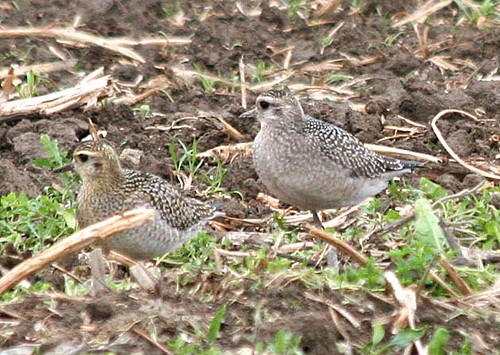tags: Pacific Golden-Plover, Pluvialis fulva, American Golden-Plover, Pluvialis dominica, birds, mystery bird, bird ID quiz
[Mystery bird] Pacific Golden-Plover, Pluvialis fulva (left), and American Golden-Plover, Pluvialis dominica (right), photographed on Fir Island, Skagit County, Washington State [I will identify these birds for you tomorrow].
Image: Marv Breece, 6 October 2008 [larger view].
Canon EOS 350D 1/640s f/7.1 at 300.0mm iso800.
Please name at least one field mark that supports your identification.
Rick Wright, Managing Director of WINGS Birding Tours Worldwide, writes:
Chubby birds in corn stubble, and biggish birds at that. Their plump shape and long wings make us think of shorebirds, and the medium-short, somewhat swollen bills make them plovers. None of the ringed plovers is this dingy or this intricately marked above, so we must be looking at Pluvialis.
The left-hand individual is regrettably foreshortened, but I can see the wingtip and tail of the right-hand bird. The blackish feathers protruding from underneath the gold-notched tertials are the primaries, and they make up a long wingtip. The uniformly dull underparts, strong supercilium beneath a reasonably well-defined dark cap, and rather weak bill rule out the bulky, big-billed Black-bellied Plover, so we're faced with golden-plovers, three species of which have occurred in the ABA Area.
Aging these birds will help. The lavishly speckled upperparts and scaly breast and flanks make them juveniles. Pacific Golden-Plover juveniles are generally more colorful than these birds, more clearly "golden" in this plumage than the grayish American. Pacific is also longer-legged, a feature hard to judge when, as so often, golden-plovers are hunkered down in the furrows. But if we look close, we can see that the tibia of the bird on the right is not significantly longer than the bird's bill; most of the "extra" leg on a Pacific is in the tibia, so my sense is that the proportions of these birds support the identification, already suggested by their dull plumage, of American Golden-Plover.
[NOTE: According to Dennis Paulson, the bird on the left is a Pacific Golden-plover while the bird on the right is an American Golden-plover]
What about the third golden-plover, European Golden-Plover? Until early October of 2008, that species had been recorded in North America only in the Canadian Maritimes; but this fall an adult finally made it to the US, landing in Maine's well-known Scarborough Marsh. Structurally, European Golden-Plover strikes me as big, fat, and square-headed, with a bill two sizes too small; I can't say that I've ever noticed the leg structure, but photographs show that species to be even shorter of tibia than American.


Sneaky! I think there are two different species here: on the left, a Pacific Golden Plover (warmer undertones in the face and neck area) and on the right, American Golden Plover (overall grayness, longer primary extension beyond tertials). Both distinguished from larger Black-bellied Plover by smaller bill relative to head and markings extending across the belly.
Hm. I was going to say American Golden-Plover, based on the primary projection that I think I can just barely see on the righthand bird, but yea, after reading JohnB's comment and taking a closer look, I think I'm voting with him: Pacific Golden-Plover on the left, American Golden-Plover on the right. Cool comparison shot!
Dobchinsky and Bobchinsky? I'll take the word of the above. Plovers I don't know at all...
I think they are both Pacific Golden Plovers, juvenile on the left and adult on the right. This is partly based on range. The primary projections on the right one bother me, but then they always do. The bills on both are the same size, so they must be the same species, and the bills are too large I think for American. They also seem bright for American.
The primary projection on the bird to the right tells me it's an American golden-plover. Cannot see the projection on the left bird but the coloration tells me it's a Pacific. JohnB's analysis is right on.
I'm eager to find out what the photographer identified these birds as (and how). I will tell you that the analysis I sent a couple of weeks disagrees with every one of the comments so far--which doesn't mean, I hasten to add, that I'm certain I'm right. I have very little experience with Pacific Go-Plo, and would be grateful for any more detailed diagnoses from those of you who know all three species well.
No doubt at all about the correctness of the photographer's identification--but I will say that I'm glad to have made a mistake on something this subtle (particularly in a photograph, where one is denied the advantage of different angles)!
So if you'll have me back, I'll keep at it.
r